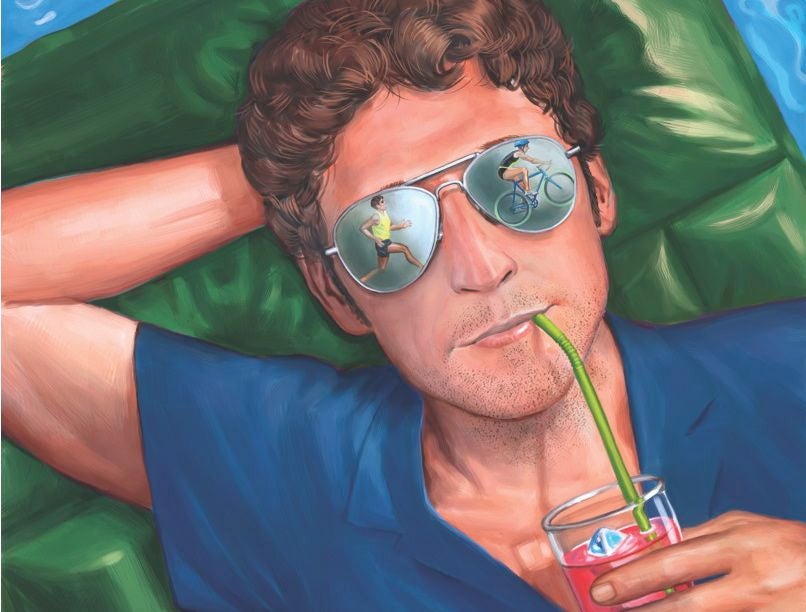Triathlife With Jesse Thomas: Take A Break

Illustration by Matt Collins.
The best training a couple of months before a big race might be little to none at all.
Congrats! You did it: You trained hard January through July and nailed your early-season “A” race. You qualified for the championships, or maybe you finished your first sprint. Booyah! Now you’ve got 8–10 weeks until said championships—or that local Olympic where you really want to beat that d-bag from sales. So what do you do? Keep the momentum rolling, right? Jump back into some solid training? Go, go, go?
Well … no. Before your late-season push, consider doing something truly unorthodox: Consider taking a mid-season break.
“A break?” you say. “Oh my God, I’ll lose 8.7 watts off my VO₂ lactate jump-reach! Never!” Chill, dudes. A mid-season break isn’t like a break after the season where you take a bunch of time off, and it’s not going to kill your mojo. It’s more like an unstructured 7–12 days that could include everything from not training at all to training very hard. It’s like a freeform, Microsoft Paint masterpiece in the otherwise Excel world of all us tri dorks.
I won’t go into all the physiological details of why a mid-season break is important because I don’t know those details. That’s my coach’s job. He says it has to do with periodization of training and werewolf cycles, or something like that. But what I do know is that if I don’t take one, come September my body gets slow and creaky and stale like when the liquid-metal guy from “Terminator 2” walks into that freezing stuff. And let’s not forget what happened to him. (He exploded.)
Last year, after a few easy days post-Ironman 70.3 Boise, I headed back to the pool and who did I see waiting for me? My swimming workout buddy Nuts (full name is Nuts Out, or 2x20x25 on 25). Nuts and I had been close buds since February, seeing each other every 5–10 days or so. He’s a good guy, helped me improve my top-end speed and stroke rate big time, which kept me in the hunt early in my races. I love Nuts, but he’d been getting on my nerves lately. I mean, we always do the same workout when we’re together, and it’s really hard.
So I called up my coach, Matt Dixon, and told him I didn’t want to see Nuts for a while. I just couldn’t do it—I needed a break. As an athlete it’s not easy to say you need a break, that you’re tired, that if you do that workout one more time you might throw up in the pool. Sure, being an athlete requires toughness, but it also requires you to be smart and listen to yourself—the latter forgotten by many athletes. I’ve been training long enough to know that not listening to your body is a one-way street to a dead end. Being tired, burnt, spent, crushed, KO’d is OK! It’s part of the process of training your body hard. If you listen to it and take some downtime, you’ll bounce back stronger.
RELATED – Triathlife With Jesse Thomas: I Eat A Lot And That’s OK
Matt was perceptive enough to know that it wasn’t just Nuts that was getting on my nerves; it was a lot of my workout buddies, like Biking Buddy 333 (3×30 min in Zone 3) and running buddy KillerLong (4×12 min at race pace). Matt suggested that I not hang out with any of my workout buddies for a little while. Not a complete break, not no training, just a break from the plan. For a week or so, I could do whatever I wanted: swim, bike, run, yo-yo, take a day off. No intervals, no timing—just whatever felt right. I took the non-plan to heart and was all over the place. I went easy, went hard, and when it rained on Saturday I watched movies. My mission was to be flexible and do whatever made me happy on the day.
It just so happened that all of this stuff went down when my pro runner wife, Lauren, was gearing up for the U.S. Olympic Track and Field Team Trials. Due to the allergies and craziness of Eugene (Track Town USA) around the championships, she needed to get out of town. So we spent the week at a friend’s house on the McKenzie River. I didn’t realize it at the time, but this played perfectly into my mid-season break plans because it meant everything I did (or didn’t do) would be new—the trails, roads, lakes, TV. Each day was an adventure, not a workout. I’d point at a place on the map and say out loud, “I want to go there.” And then I’d go there and play triathlon.
You know what I didn’t do during my break? Swim in a pool. I logged some serious time in the pool this past winter and spring. It’s paid huge dividends for me in my weakest event, but it’s also my least favorite thing to do in triathlon, by a lot. I’d spent the whole winter/spring working on my weaknesses, and now it was time to enjoy my strengths. So I ran trails and rode mountains and rediscovered what I love about triathlon. I even swam once, but only because it was in a beautiful lake, and it felt cool to say I swam across it.
The idea is simple: While you may feel like a million bucks coming off your big result, your body is most likely going to have a tough time hanging on to that fitness for another couple of months. And if you try to force the issue? Liquid-metal explosion.
Jesse Thomas (@jessemthomas) is a second-year pro and the 2011 and 2012 Wildflower Long Course champion. He lives in Springfield, Ore., with his wife, American 5K champion Lauren Fleshman, and is the CEO of Picky Bars (Pickybars.com).